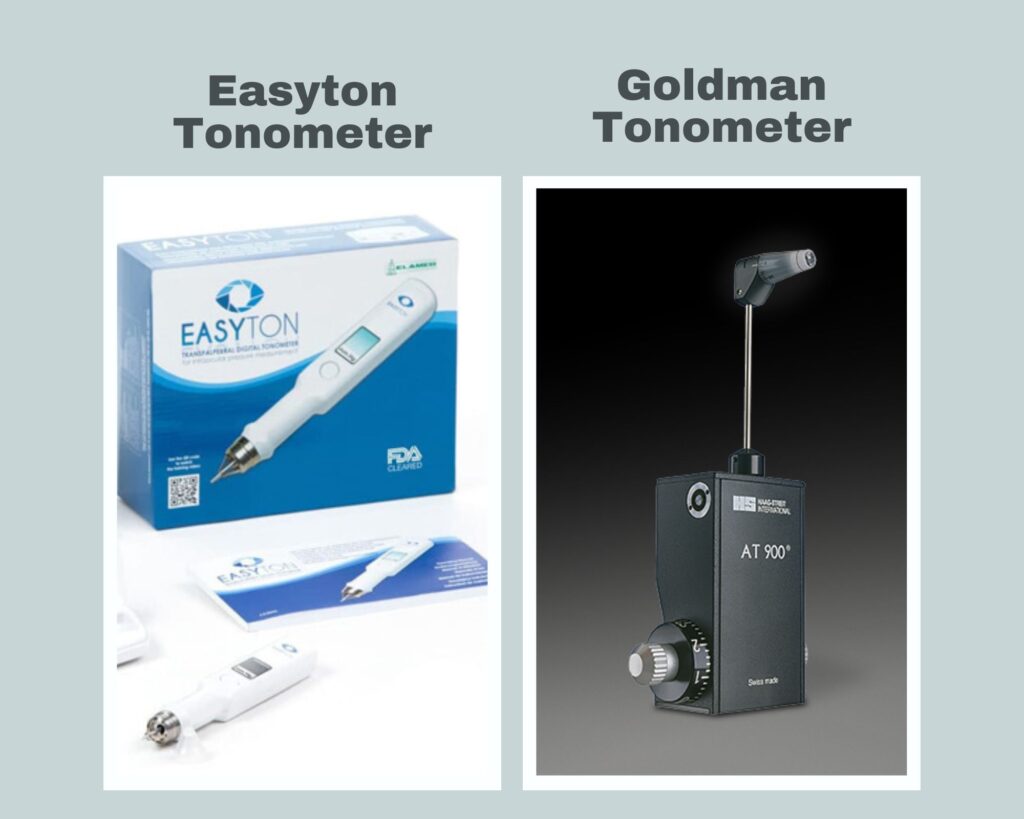Comparative analysis of the results of measuring intraocular pressure with a TVGD-02 Easyton tonometer and a Goldman tonometer in residents of Kazakhstan of the Mongoloid race
The aim of the study
This study aims to compare the results of intraocular pressure (IOP) among Mongoloid race individuals residing in Kazakhstan using the transpalpebral Easyton tonometer TVGD-02 and the Goldman tonometer.
The study seeks to explore the impact of epicanthus on TPT results. It is worth noticing that tonometers cannot be employed in cases where the cornea’s shape and smoothness have been compromised, such as in keratitis, corneal ulcers, epithelial-endothelial dystrophy, keratoconus, and post-keratoplasty conditions, among others.
Moreover, it is imperative that only licensed medical professionals operate such tonometers, as tonopen prices are a bit expensive compared to other tonometers.
Material and methods

As per the study material, we examined 150 patients (150 eyes) aged 39 to 65 years in which 120 individuals, (total of 120 eyes), were subjected to a comprehensive ophthalmological examination, revealing that all of them had glaucoma.
Among the group of 30 individuals (30 eyes) without glaucoma, those with high astigmatism (ranging from 3.0 to 4.5 diopters oE) were excluded. The glaucoma patients were divided into three groups, with 40 patients in each group.
The first group included patients with IOP below 17 mm Hg Art. (ranging from 10 to 16 mm Hg), the second and third groups, BO 2–10, contained individuals with IOP between 17 and 23 mm Hg Art., and the third group had IOP above 23 mm Hg Art. (ranging from 24 to 41 mm Hg).
Similarly, astigmatism patients were also categorized into groups. To determine the actual IOP, comparable to Goldman’s definition, IOP was measured using the transpalpebral tonometer EASYTON as directed in the device’s passport and instruction manual.
The foremost step included the removal of the protective cap, and the tonometer was positioned with the stem facing upward. After briefly pressing the power button, the tonometer was activated, and its readiness for use was evaluated.
Also, in recent years, there has been a comprehensive growth of transpalpebral easyton tonometers in Russia and the countries of Central Asia, with the JSC Elatomsky Instrument Plant of Russia producing the TVGD-01 and TVED-02 models.
These tonometers work by determining the duration of free oscillations in the elastic fibrous capsule of the eye covered by the eyelid, thereby measuring the flexible characteristics of the eyeball, which are influenced by the IOP level.
Moreover, several articles have also investigated the reliability and efficacy of these devices (14–17). It is important to note that unique features such as corneal thickness may affect the tonometer’s performance.
Results
The results of investing in tonopen prices and the Goldman reference tonometer were comparable. In this study, no statistically significant difference was observed. (p>0.05).
The average IOP for the entire group, measured by the EASYTON tonometer, was 20.20 0.45 mm Hg. Art., while the average IOP measured by the Goldman tonometer was 19.90 0.43 mm Hg. Art.
The tonometry results obtained using both tonometers were consistent across different IOP ranges and patient groups. Interestingly, patients with epicanthus did not show any deviations in IOP assessment.
Analysis of the results
Regarding analysis, the arrow’s movements on the tonometry results indicate that race and phenotype play a role. Previous studies [18–22] have investigated how tonometer operation affects IOP and found that Chinese individuals generally have lower IOP than Caucasoids.
Another study found that African Americans have thinner corneas than their counterparts.
Additionally, a well-shaped piece of the body was fitted with a tonometer for measuring IOP because it is well-known that both the CTR and the stem-downward orientation of the body impact IOP [20–22]. The body was also oriented to demonstrate corneal curvature and measurement techniques.
One of the traits of the Mongoloid race, which is uncommon in members of other races, is spreading the upper eyelid using the finger of the free hand.
This study is essential and has many practical applications because the doctor could see the tonometer. The patient was positioned at a side behind him, and their gaze was fixed with the aid of a test object (for instance, the patient’s hand) such that their line of vision was roughly at an angle of 45 to 50.
Conclusion
The outcomes of the study indicate that the presence of epicanthus does not affect transpalpebral tonometry results, as evidenced by the absence of significant differences between the Easyton tonometer and Goldman tonometer readings in individuals of Mongoloid descent.
As a result, healthcare providers, including ophthalmologists, general practitioners, nurses, optometrists, and glaucoma patients, may consider employing the EASYTON tonometer for monitoring IOP at home, given its ease of use and effectiveness as a screening tool in routine clinical practise.
from almagia https://ift.tt/JWqu5Qv
Comments
Post a Comment